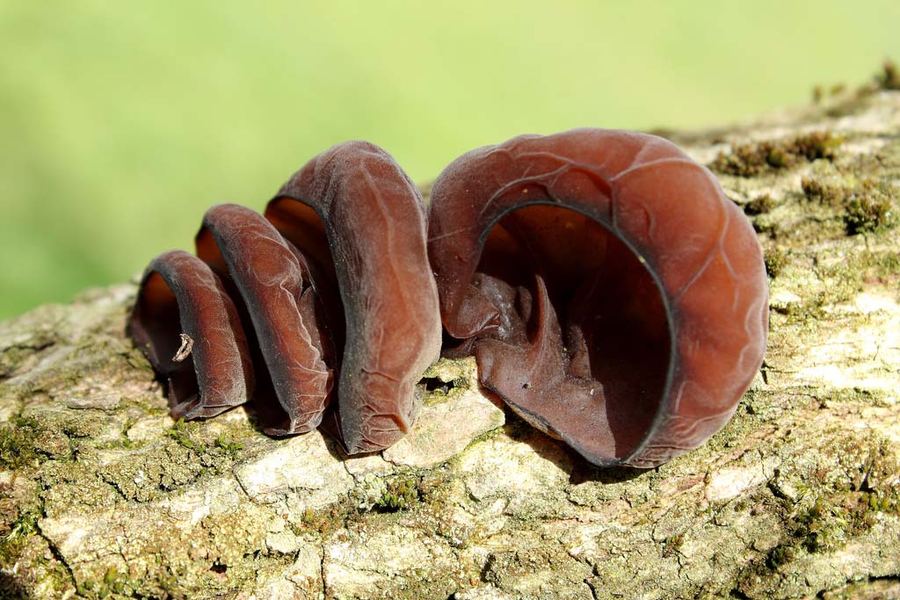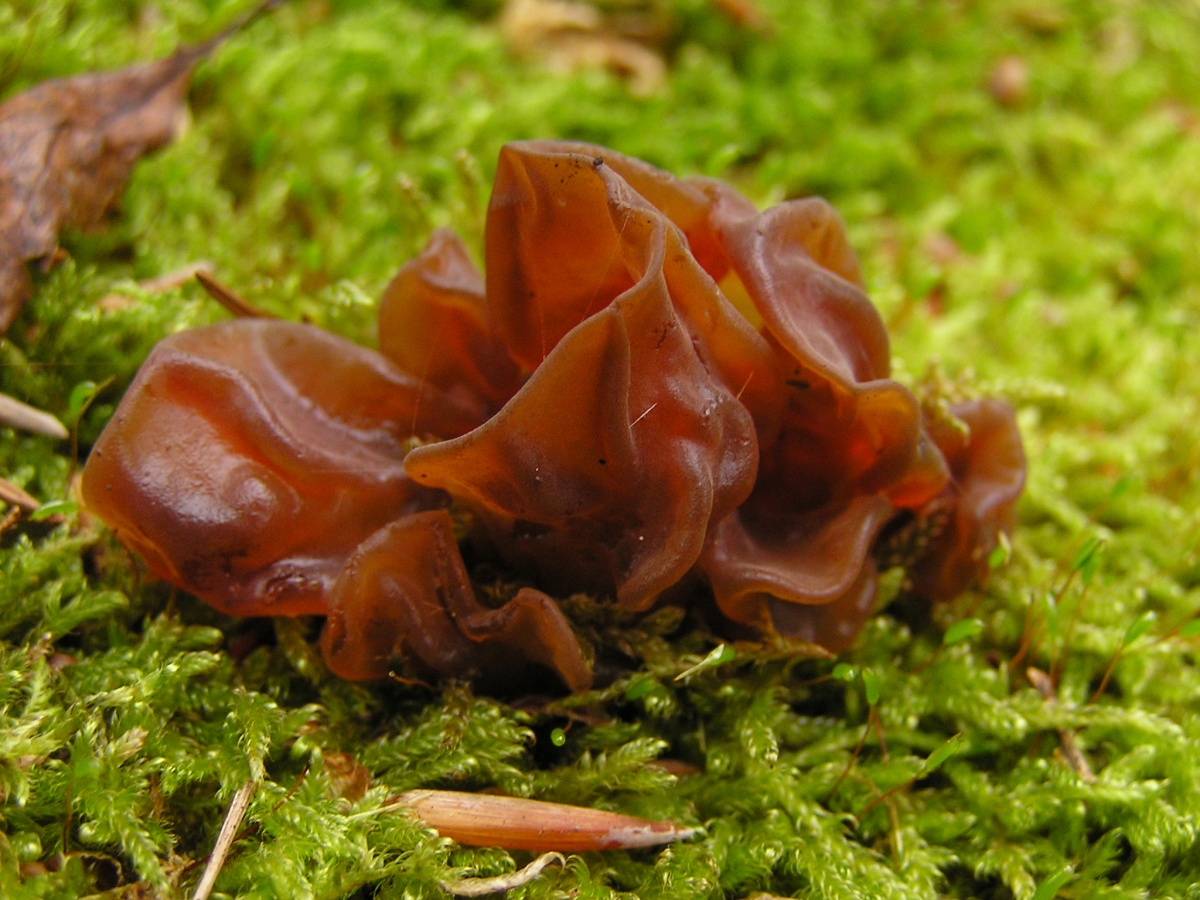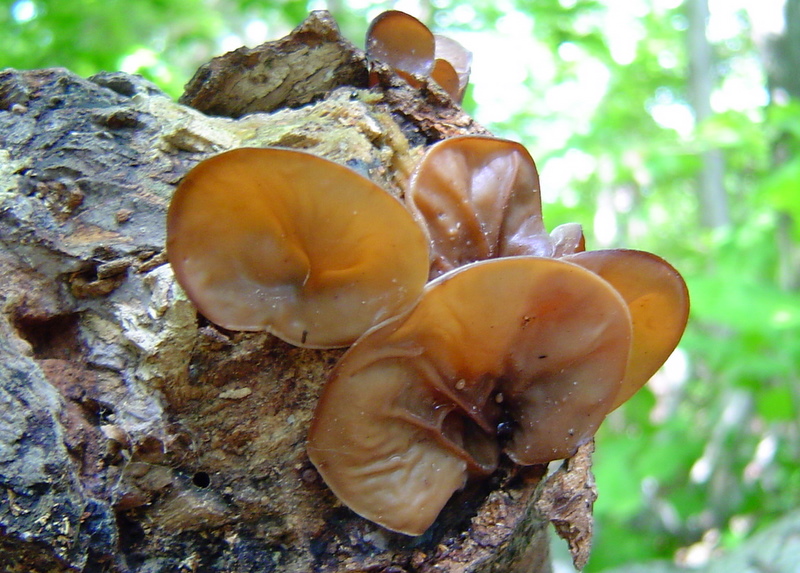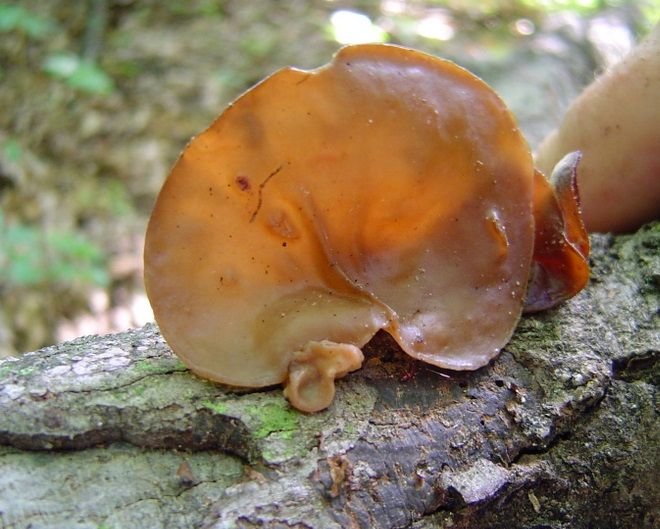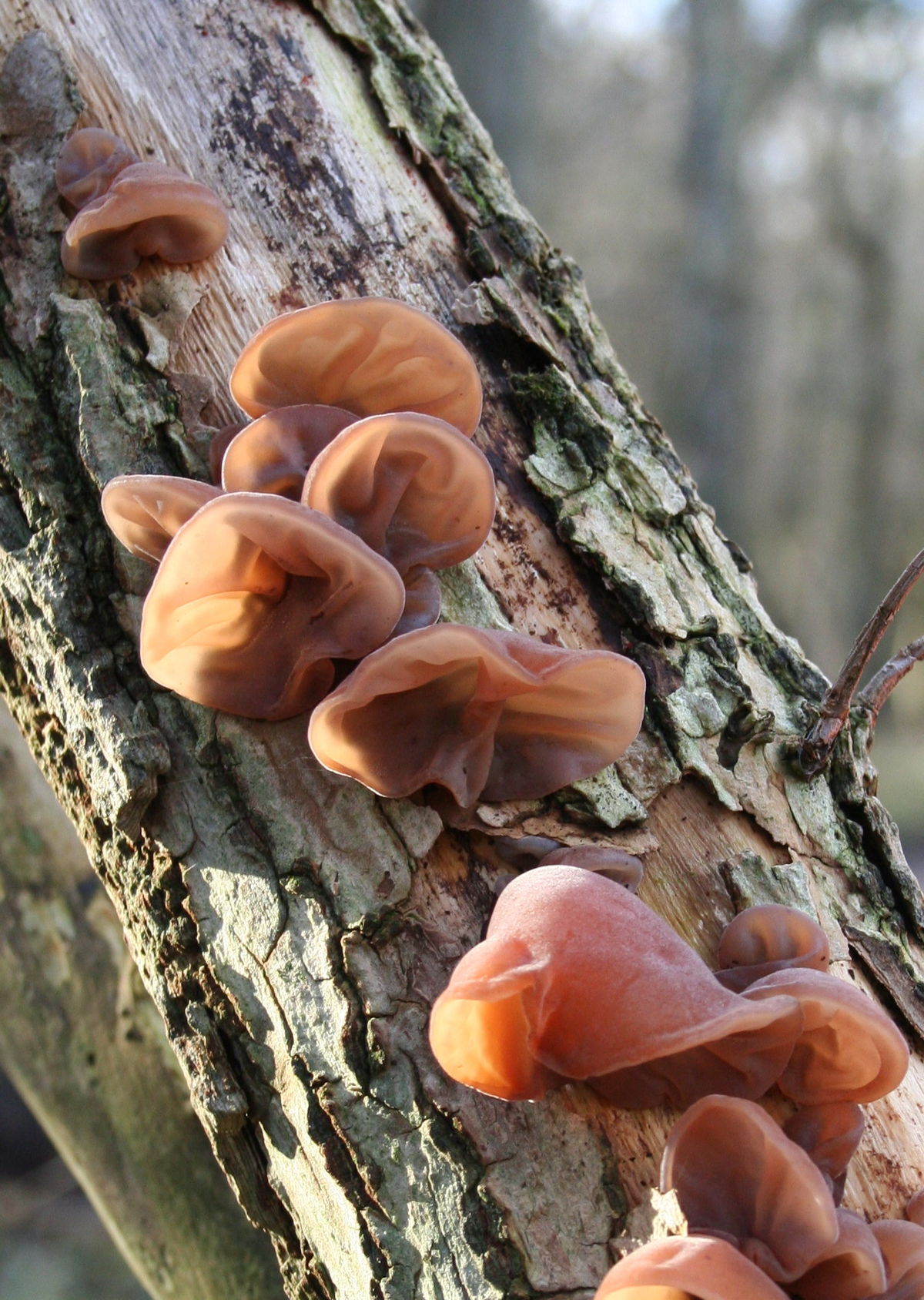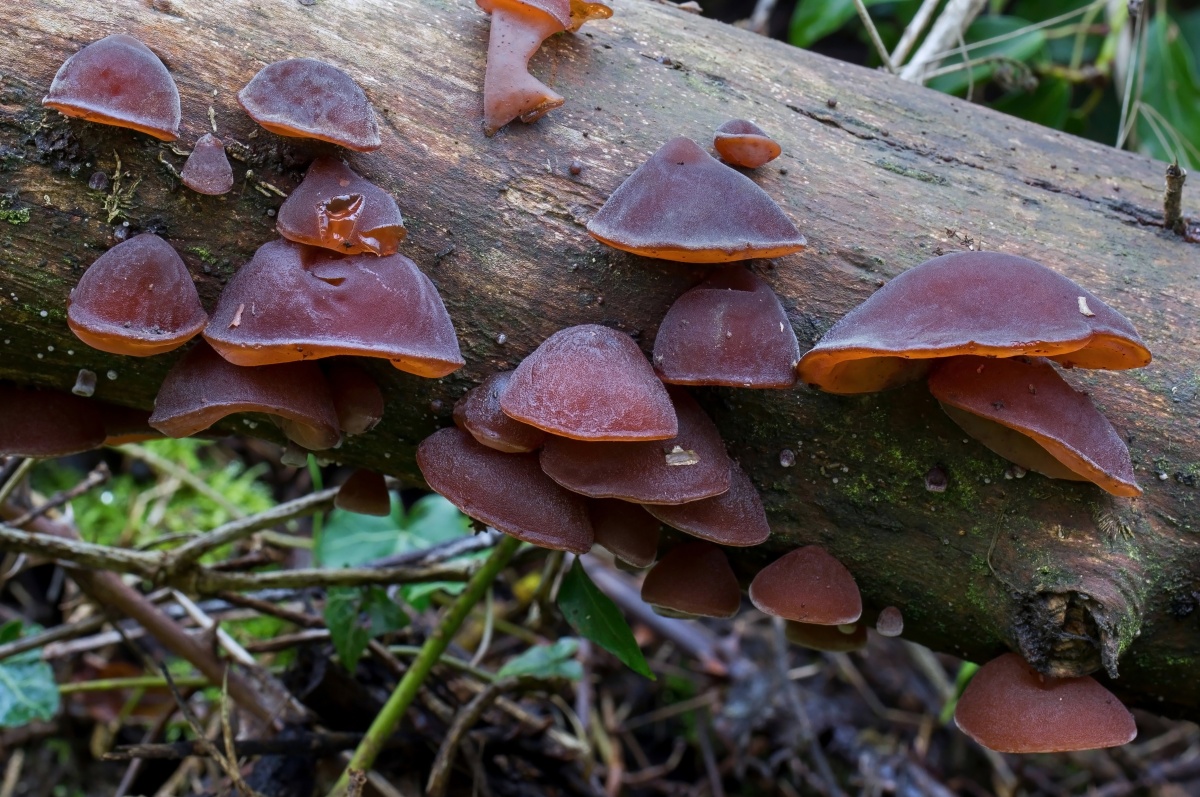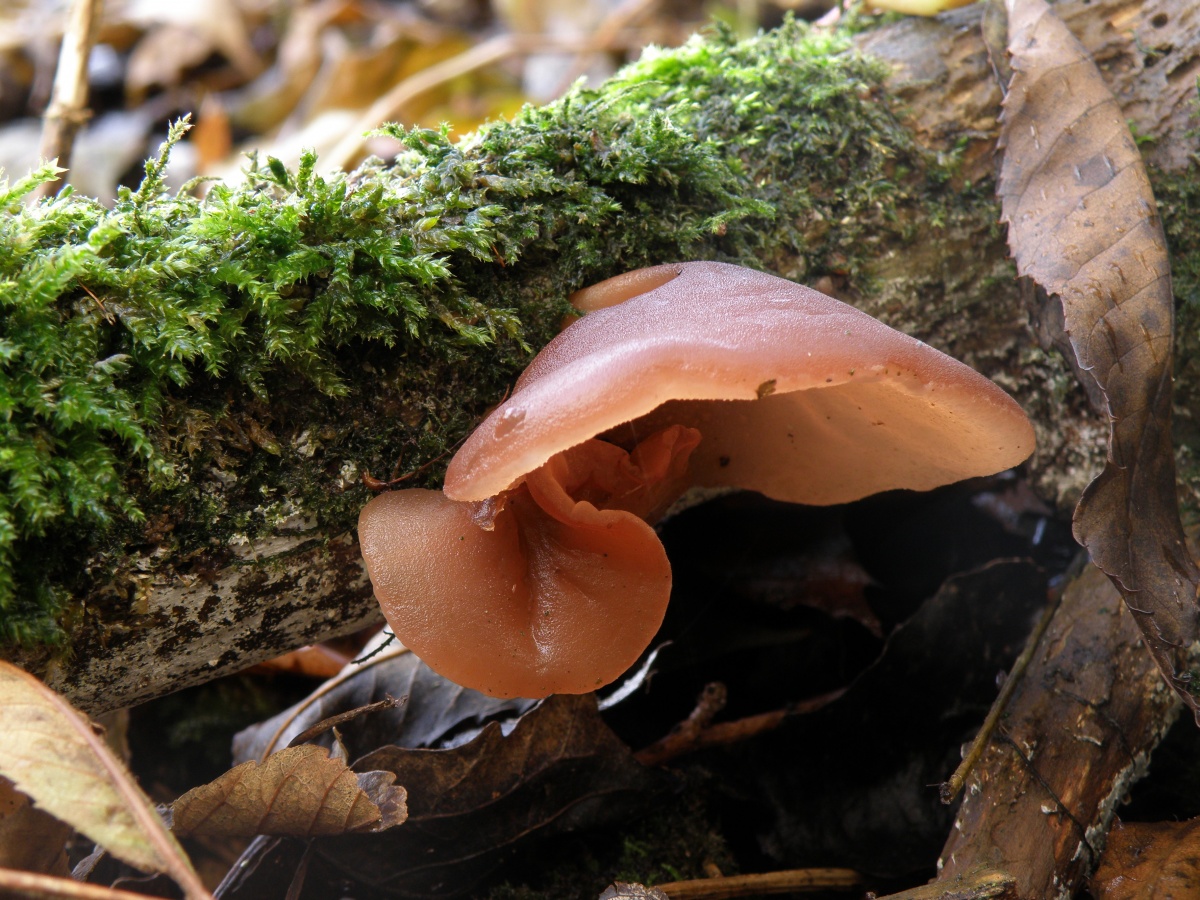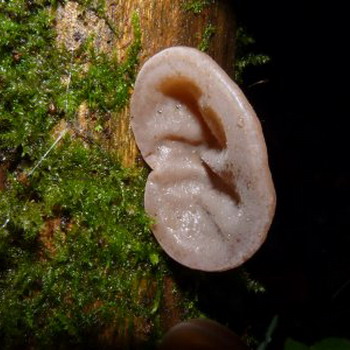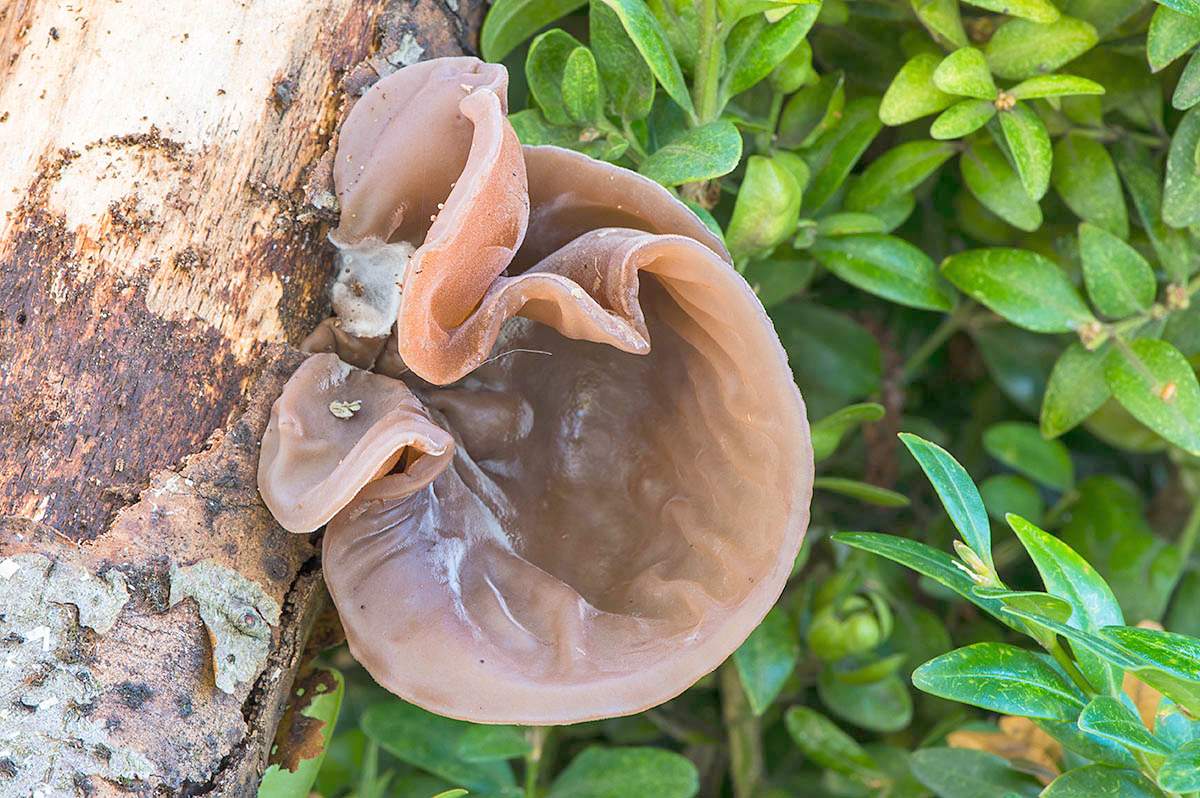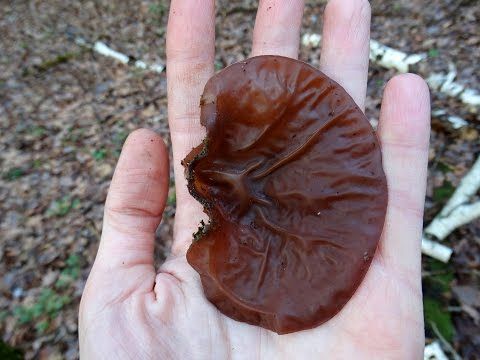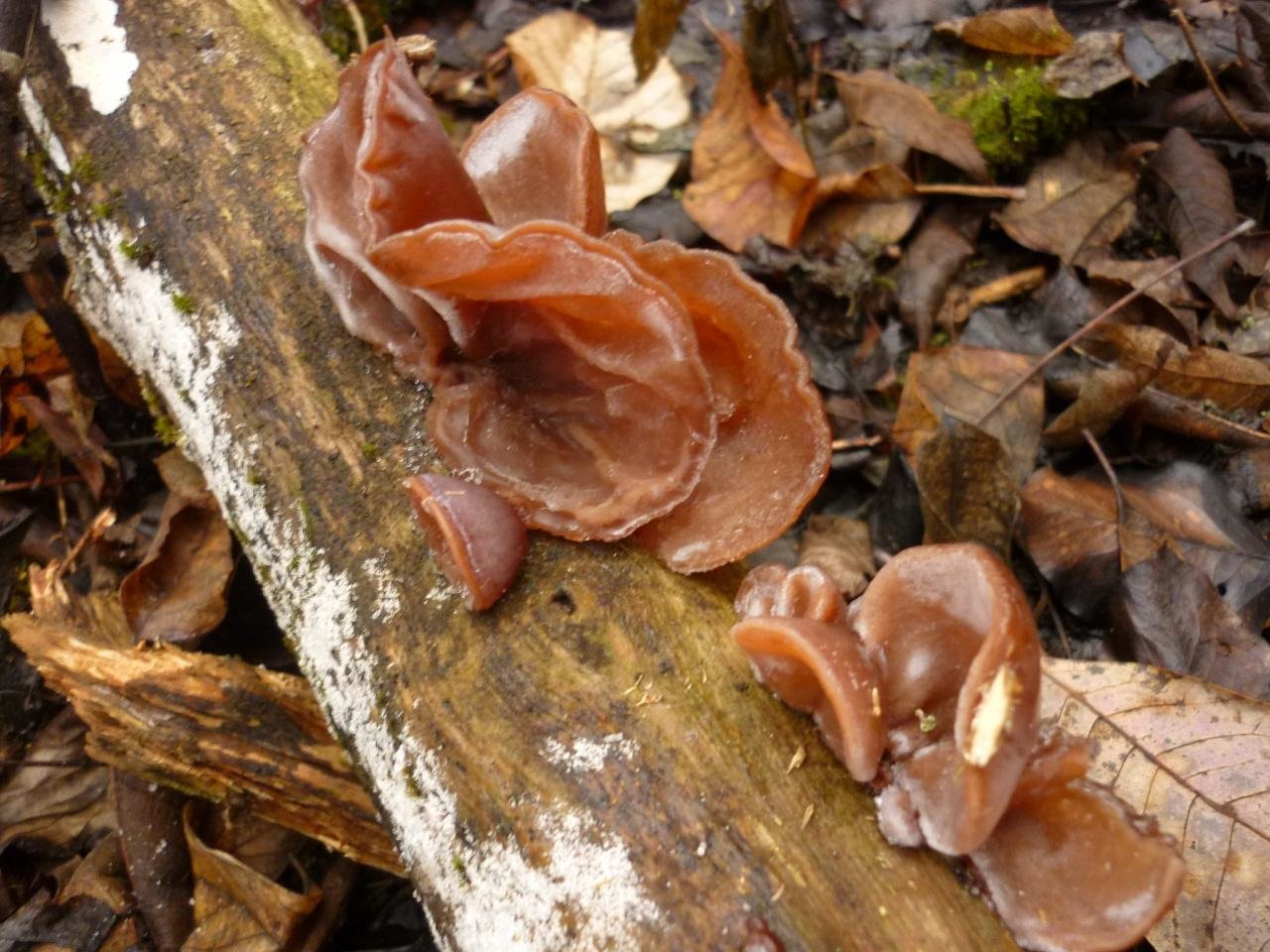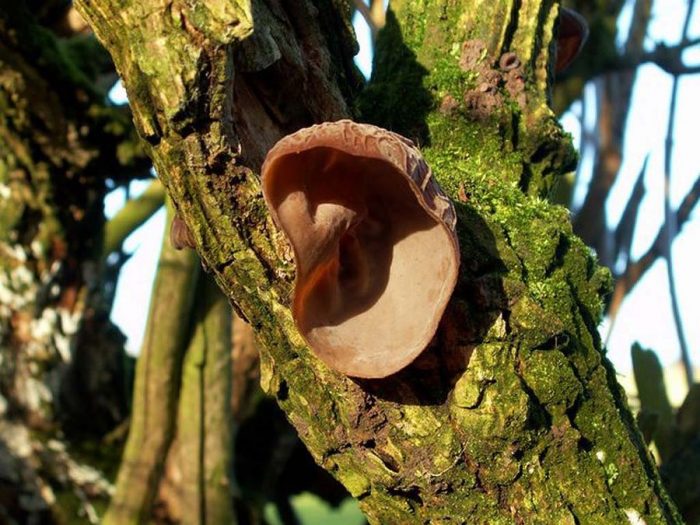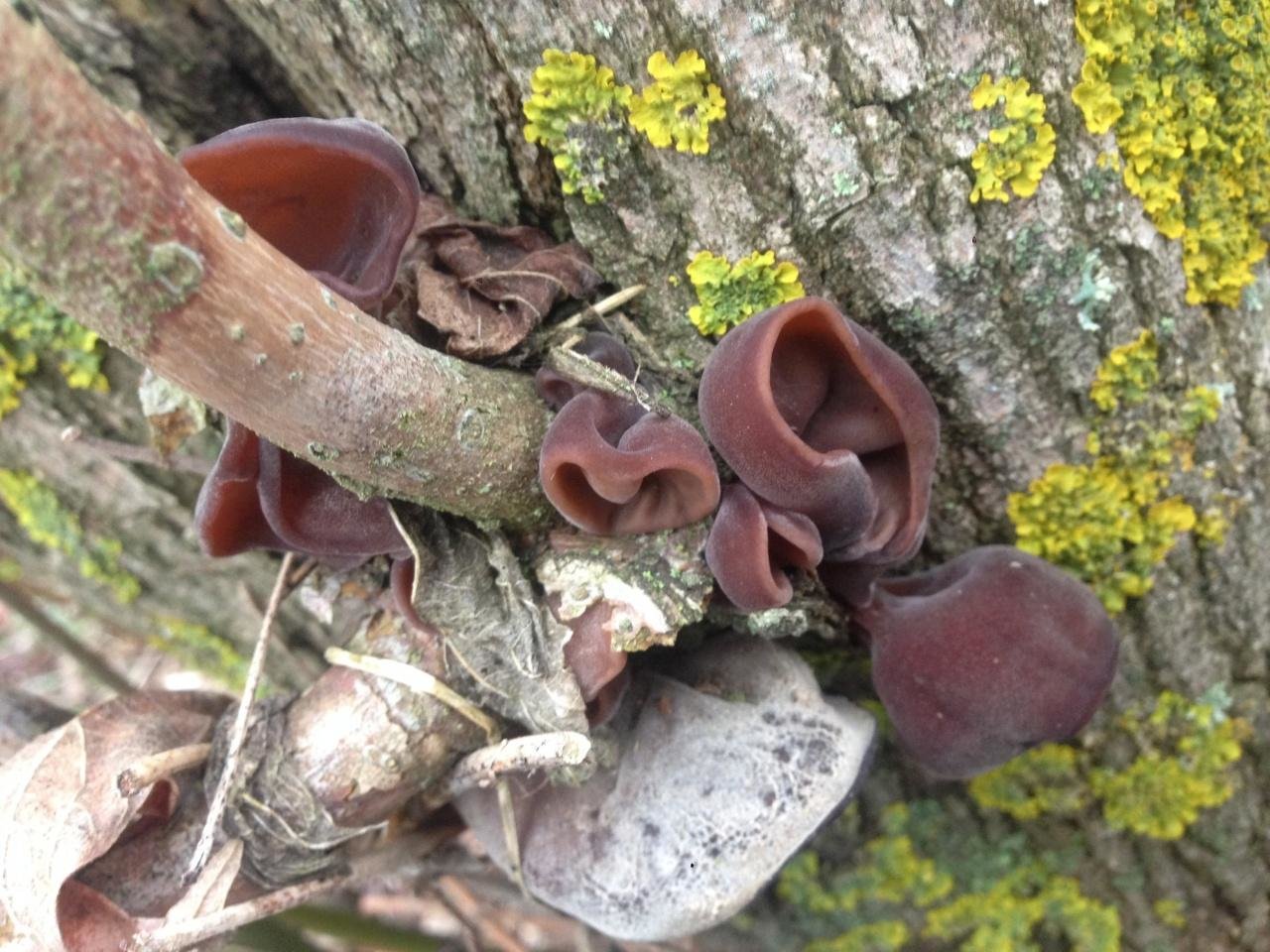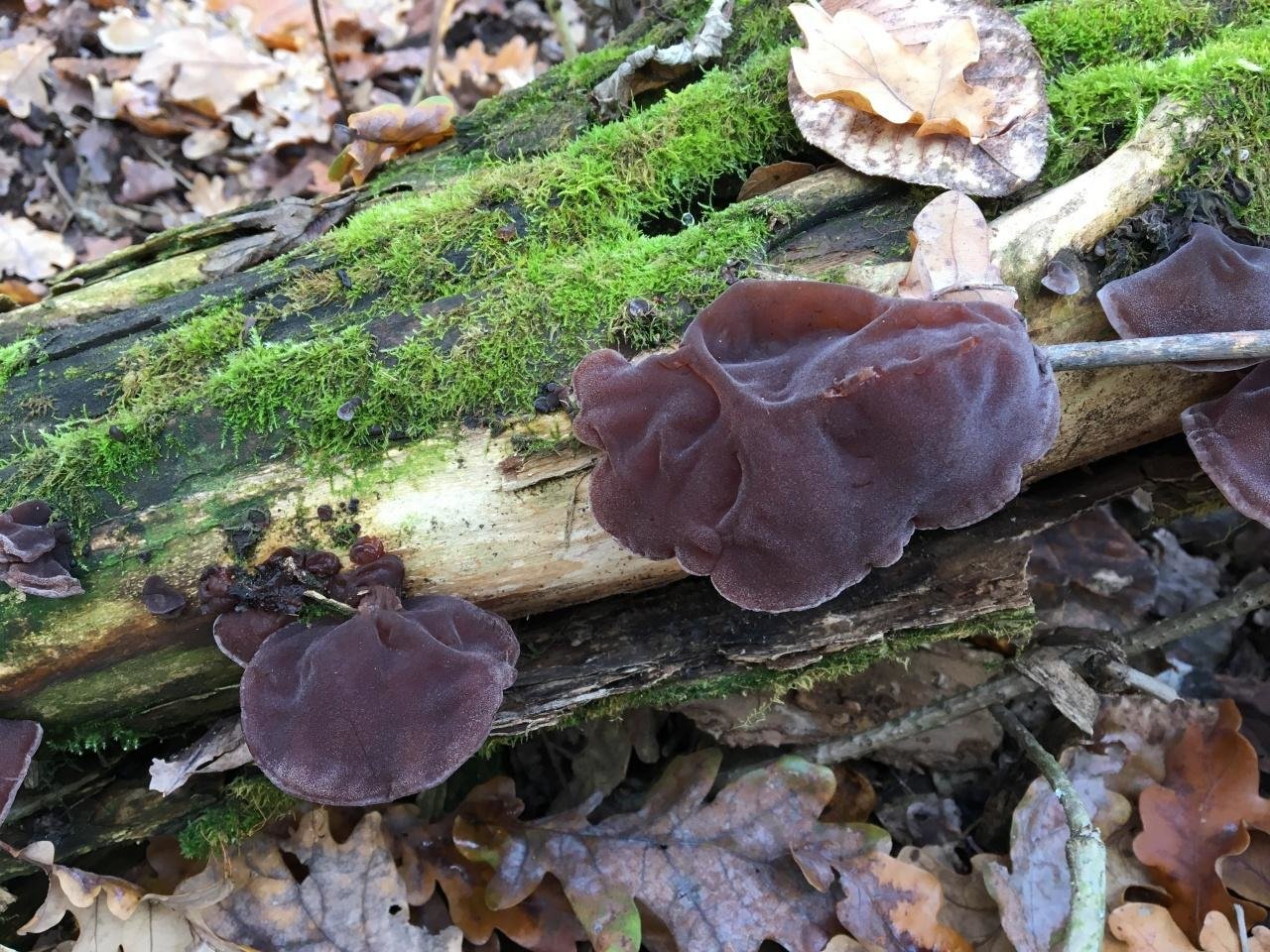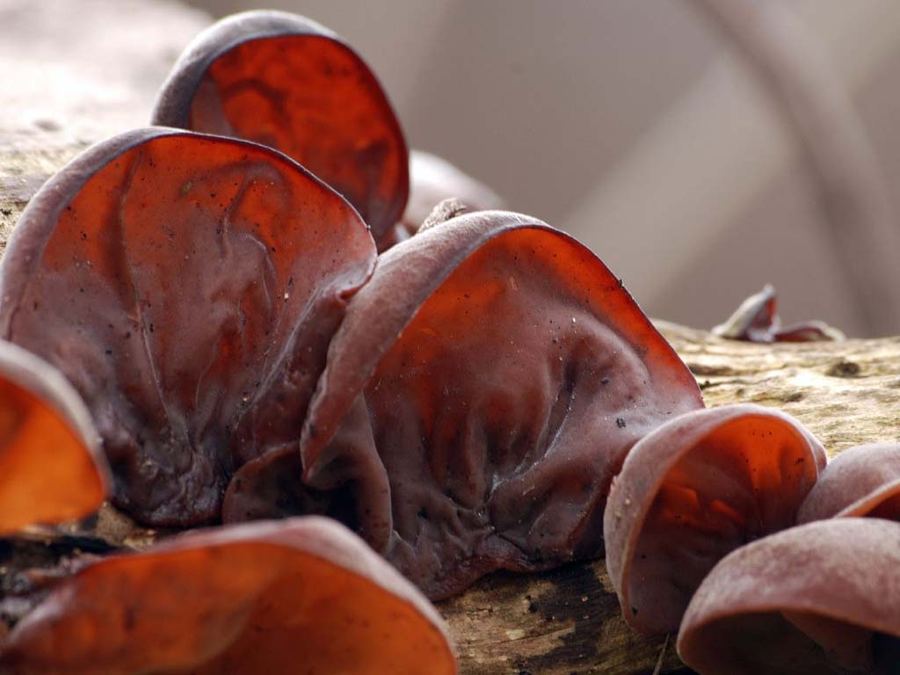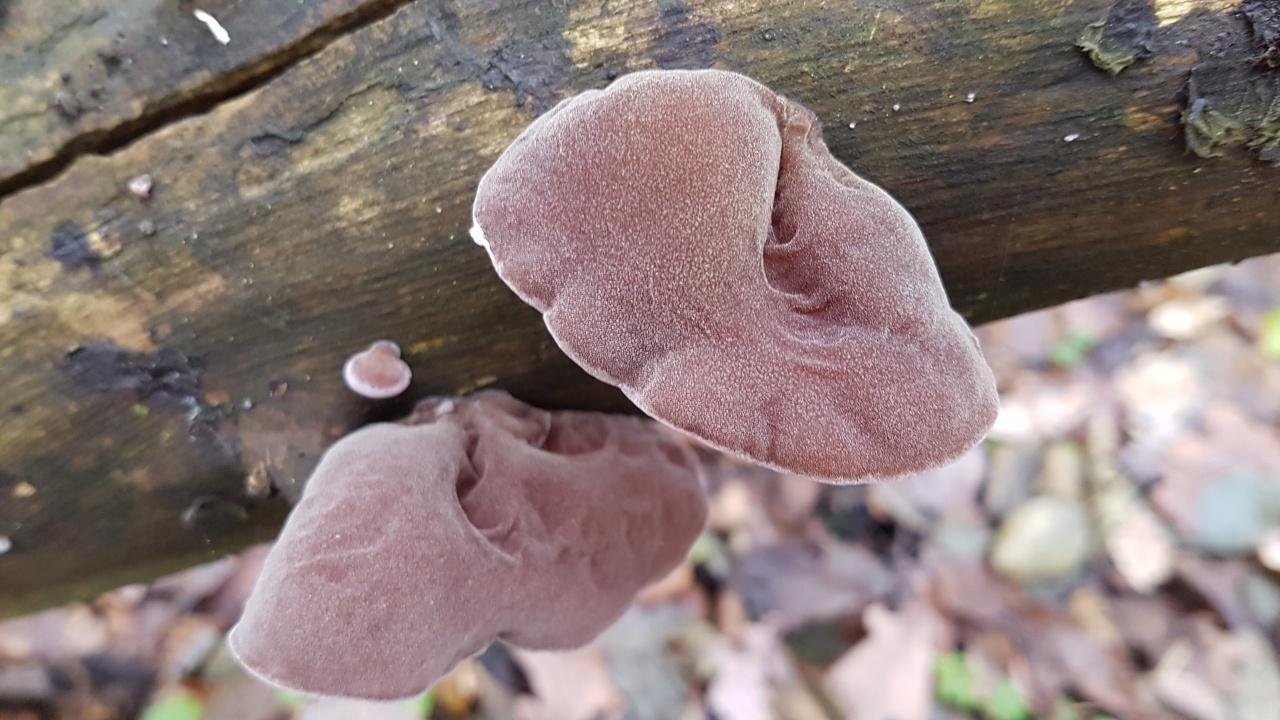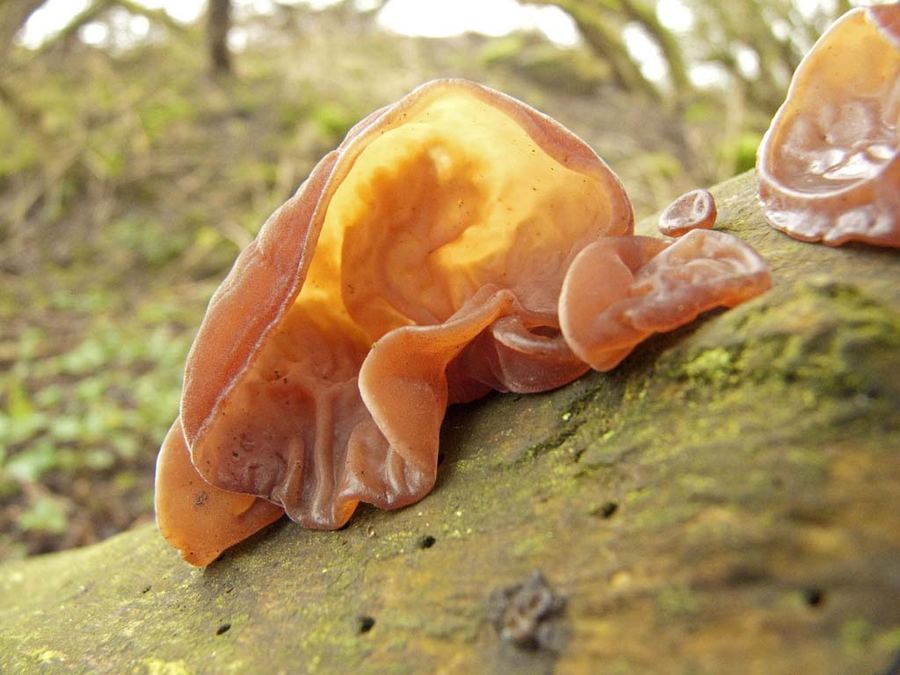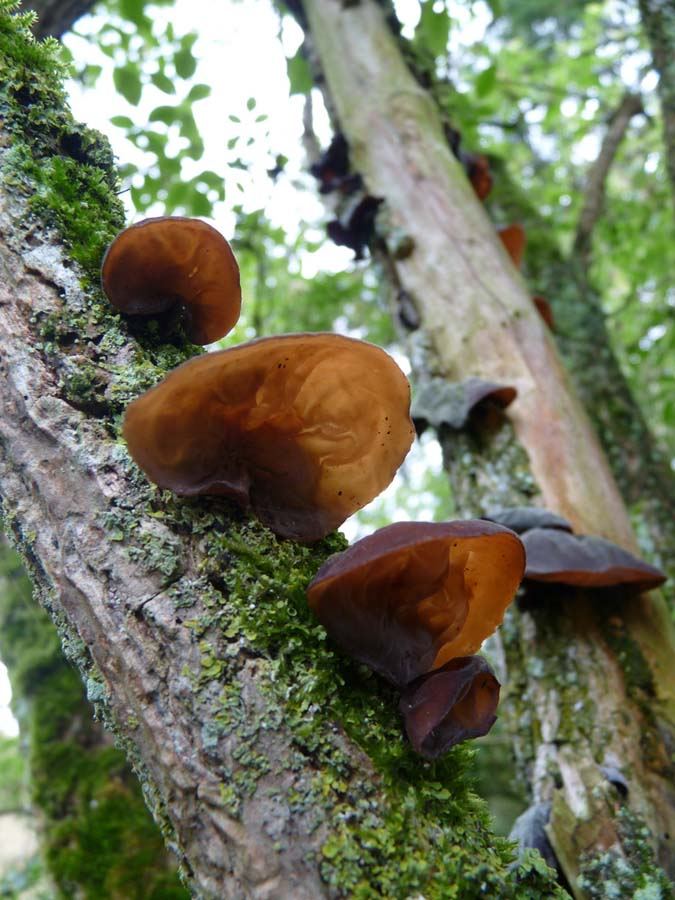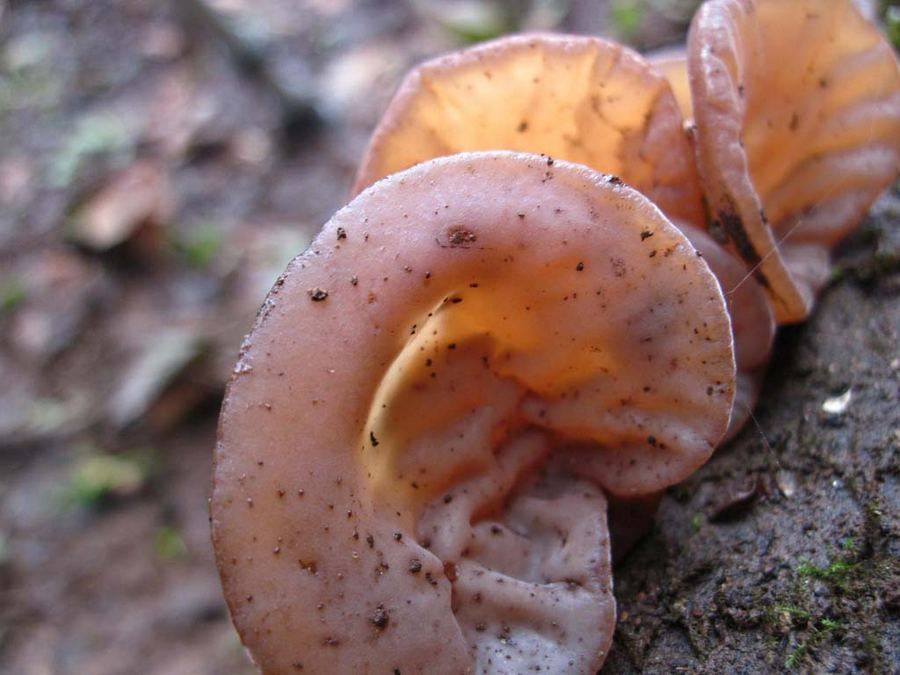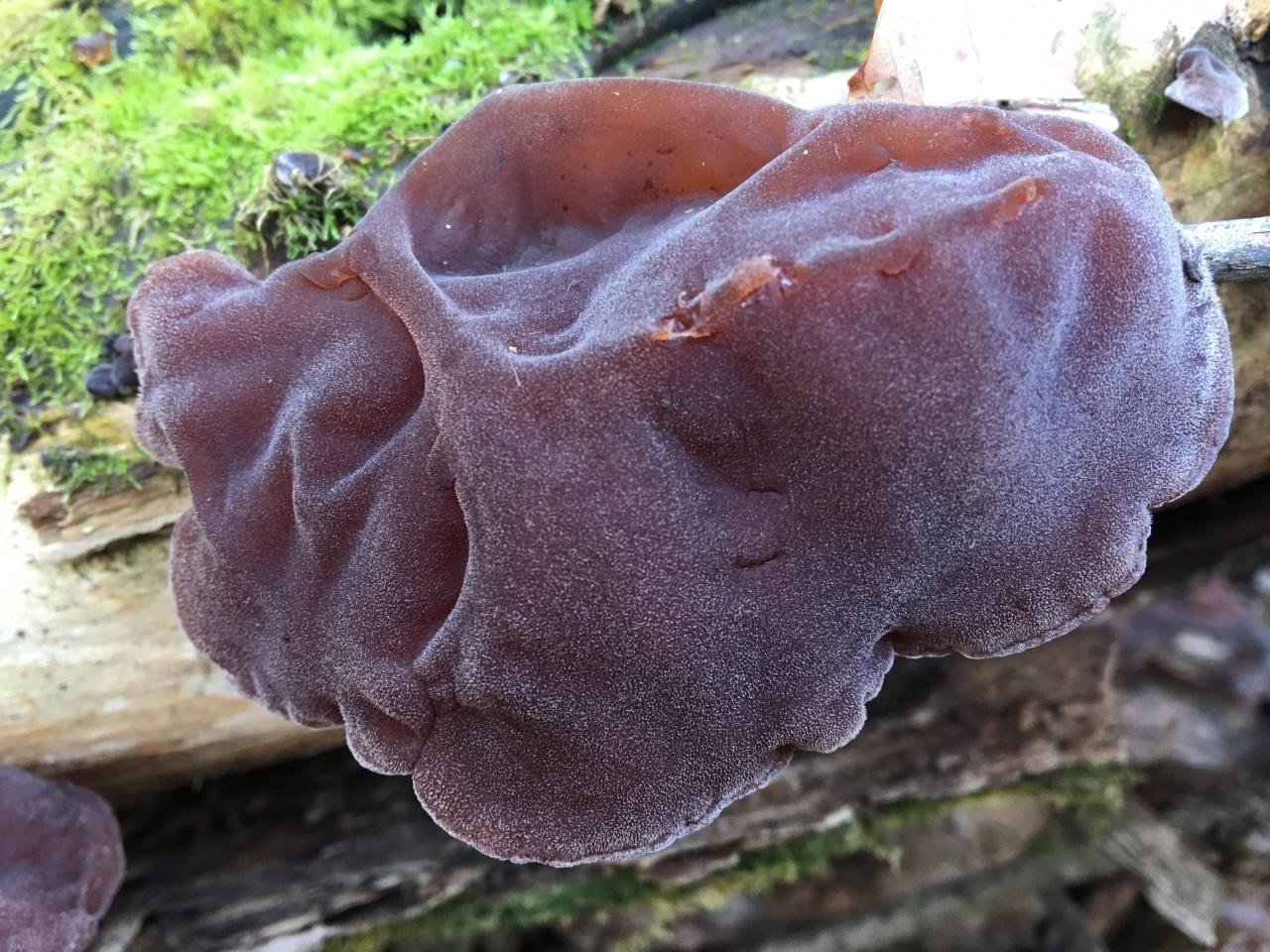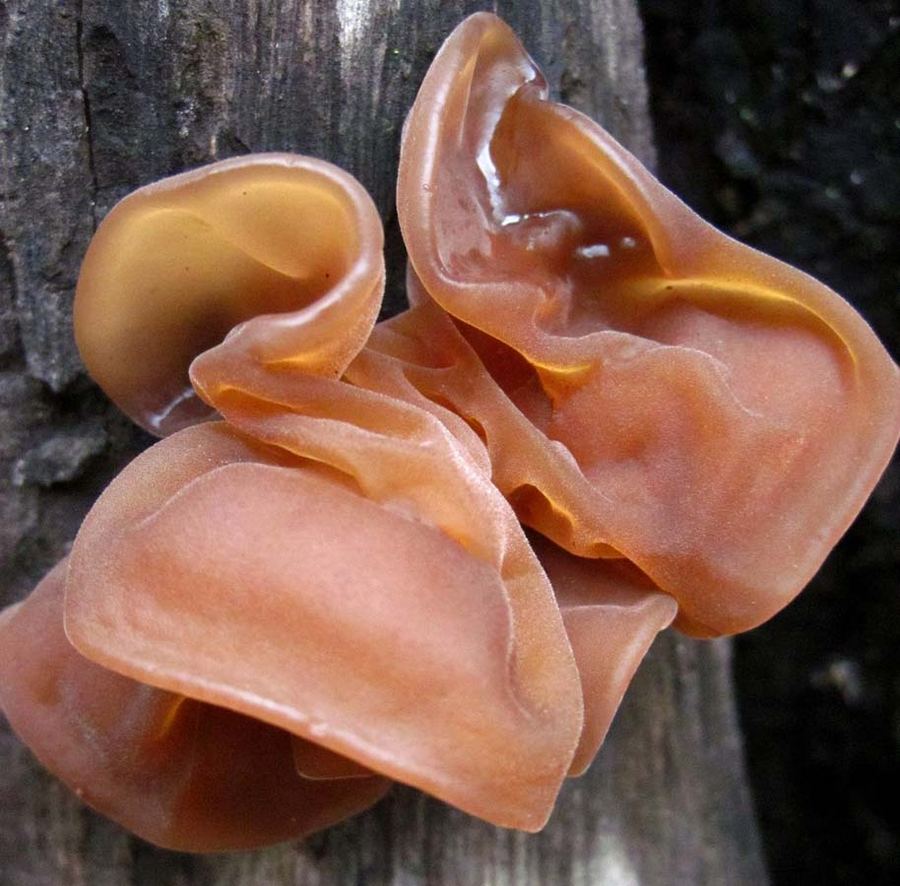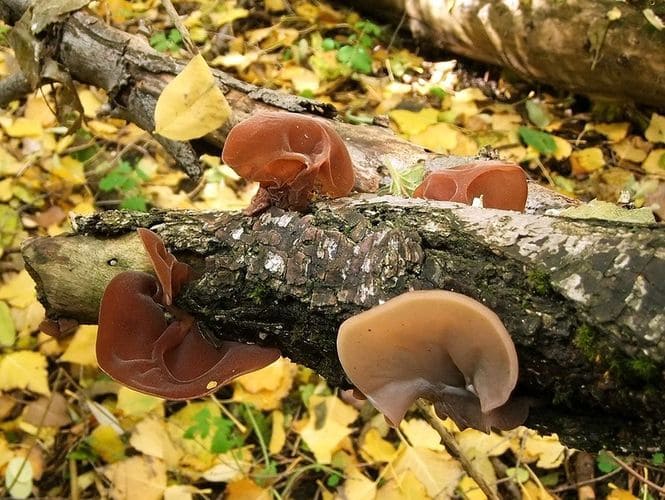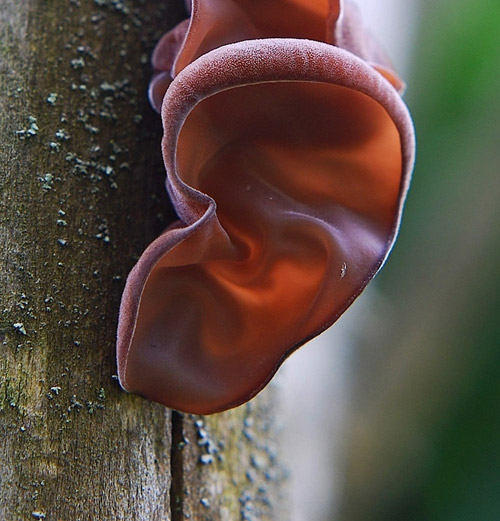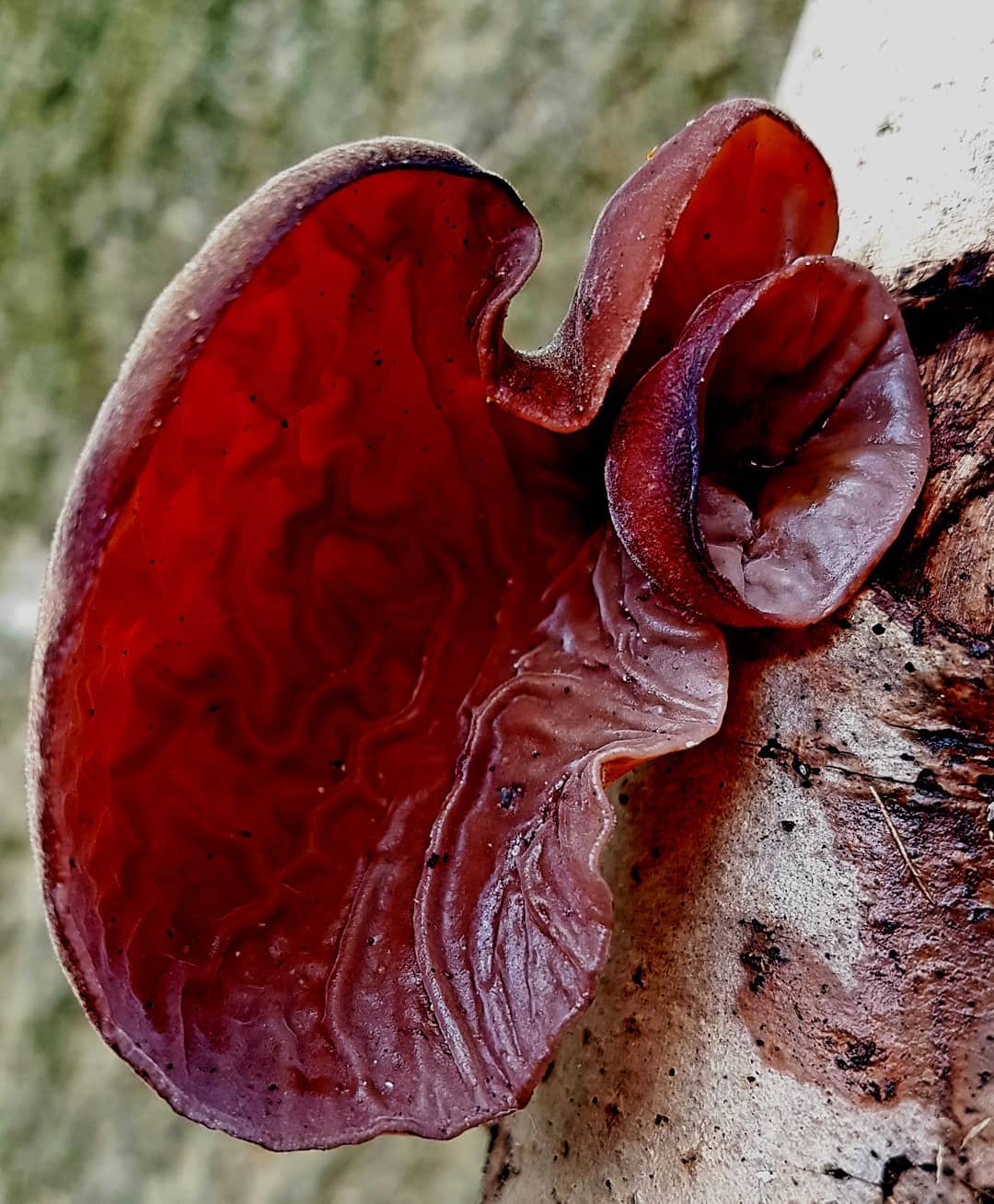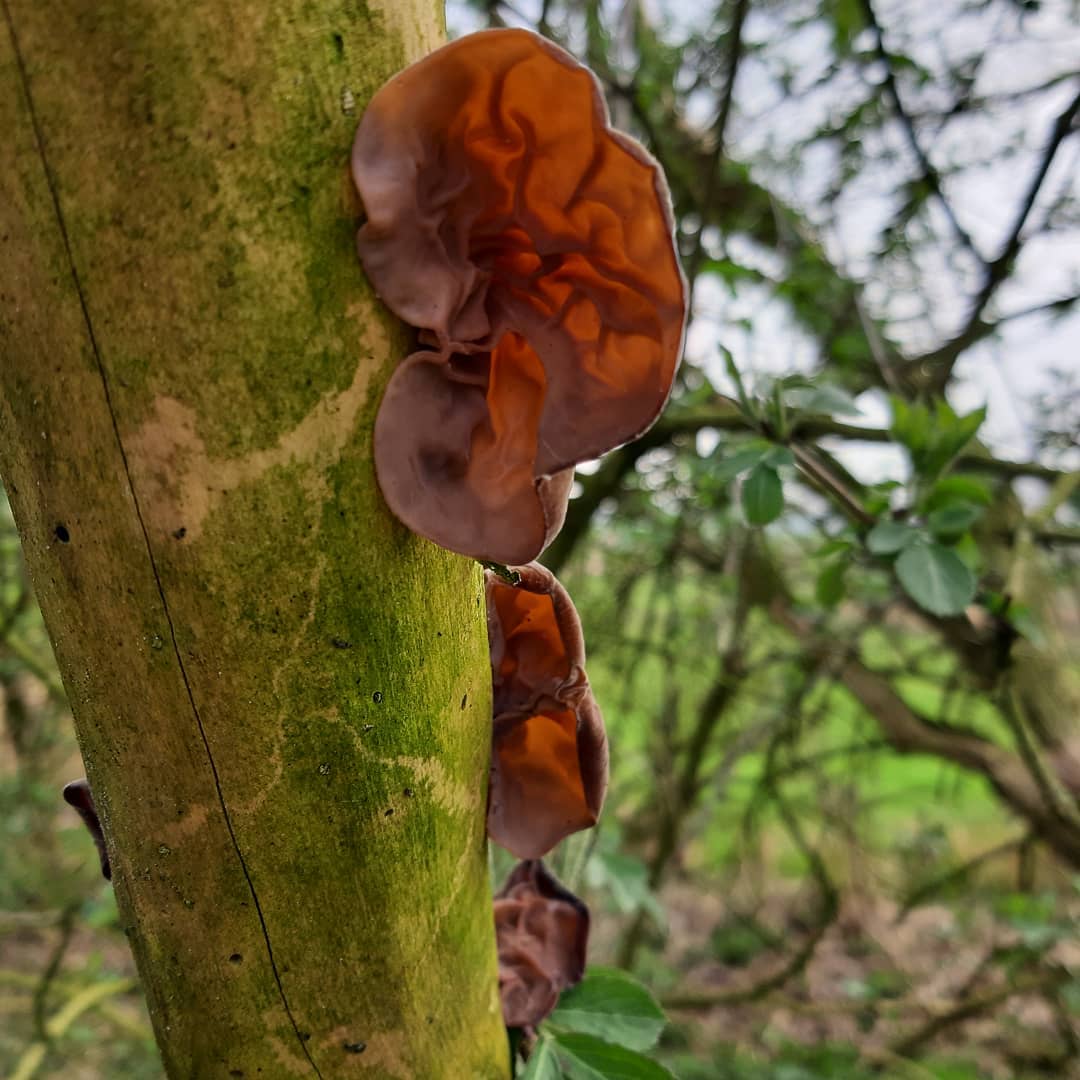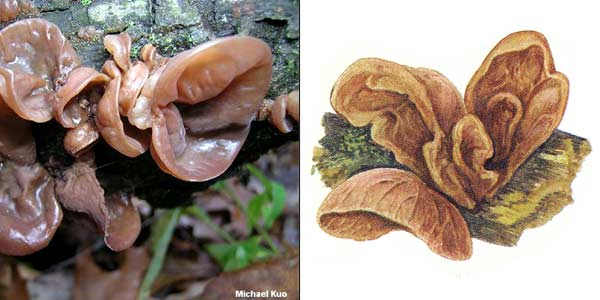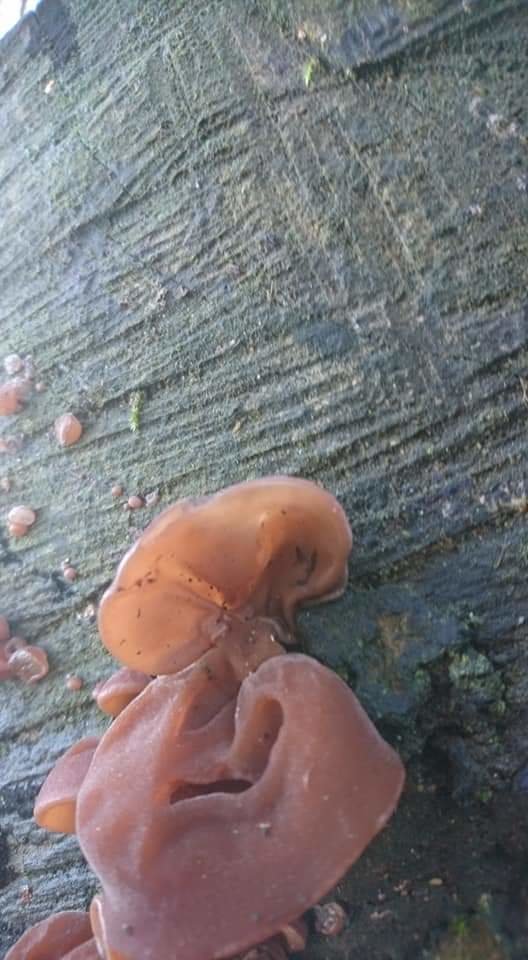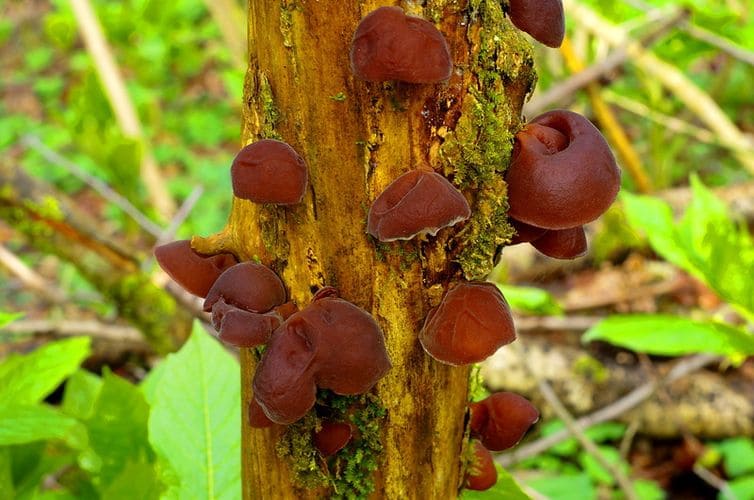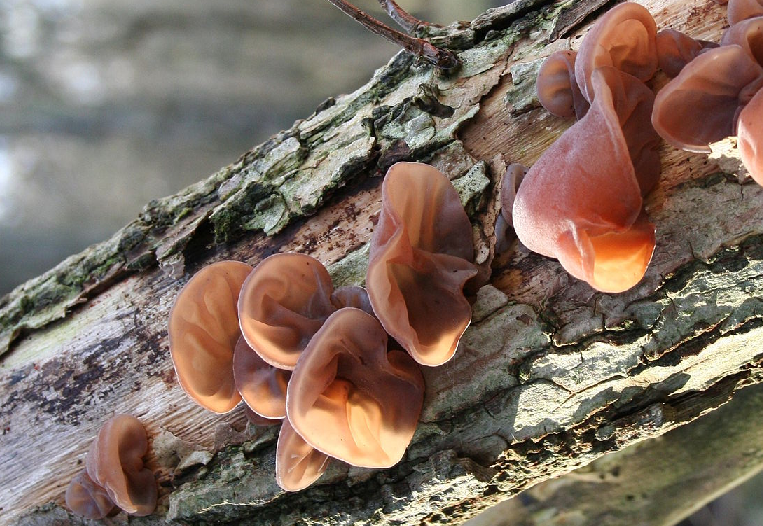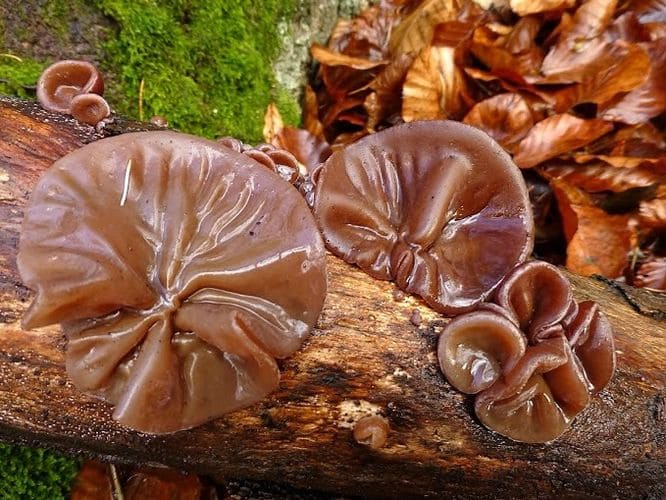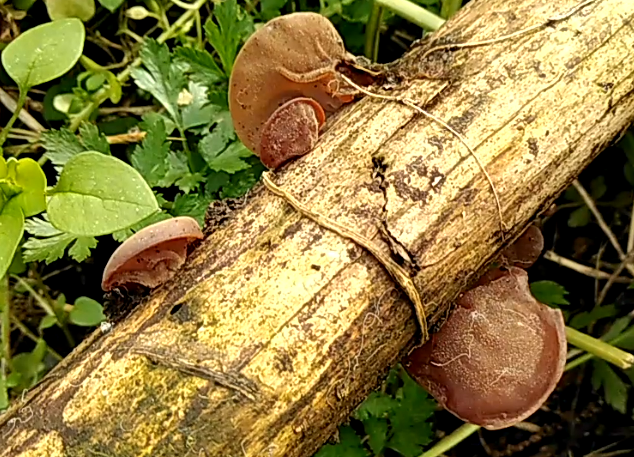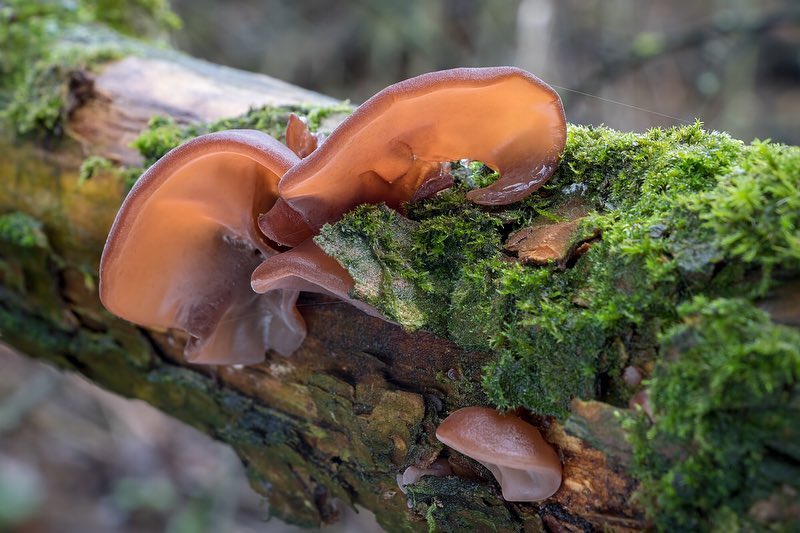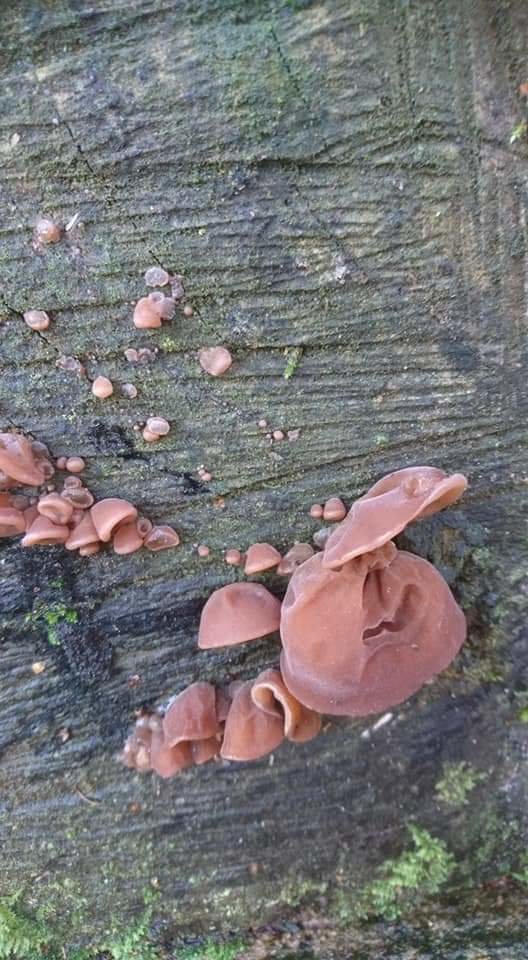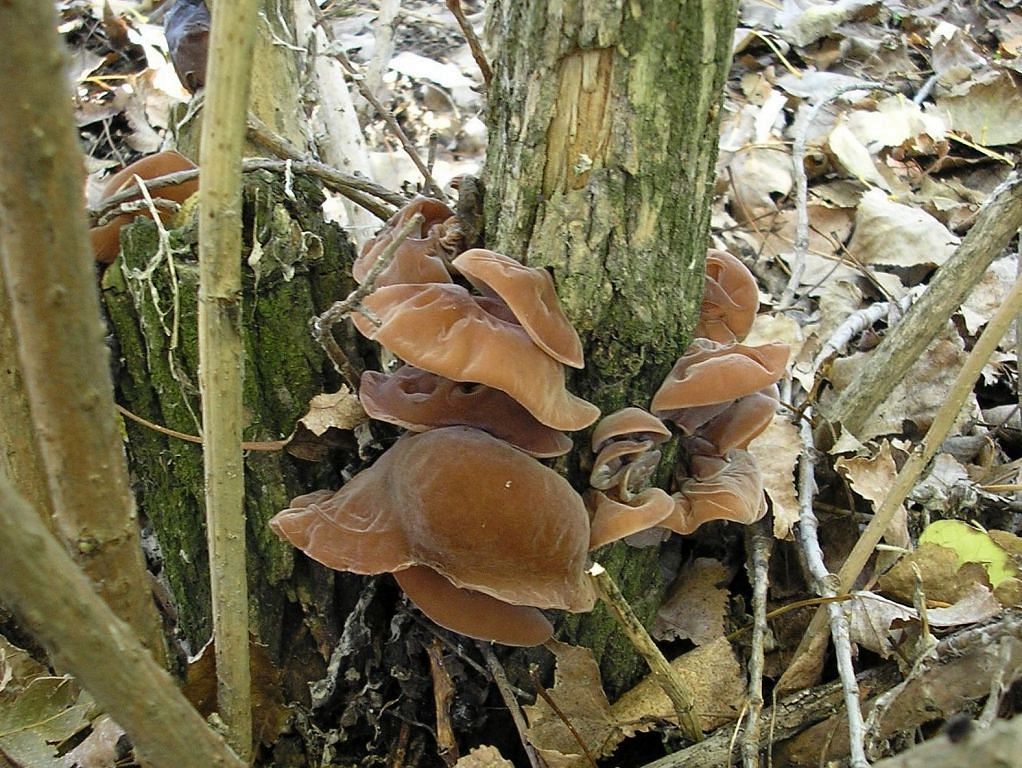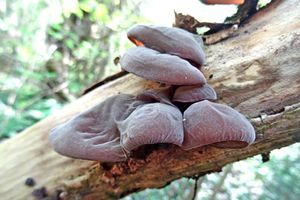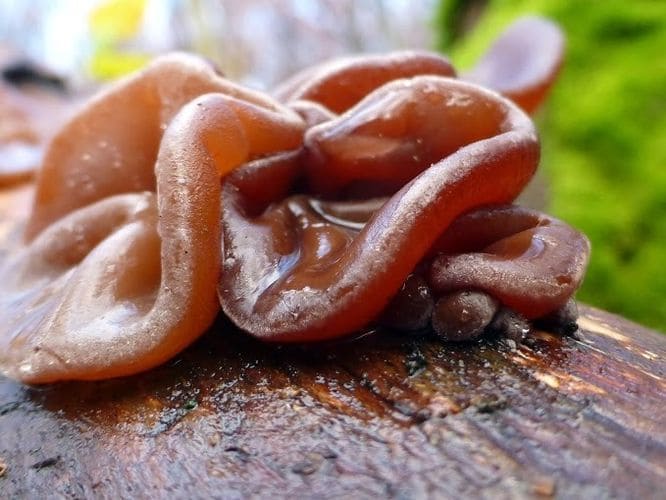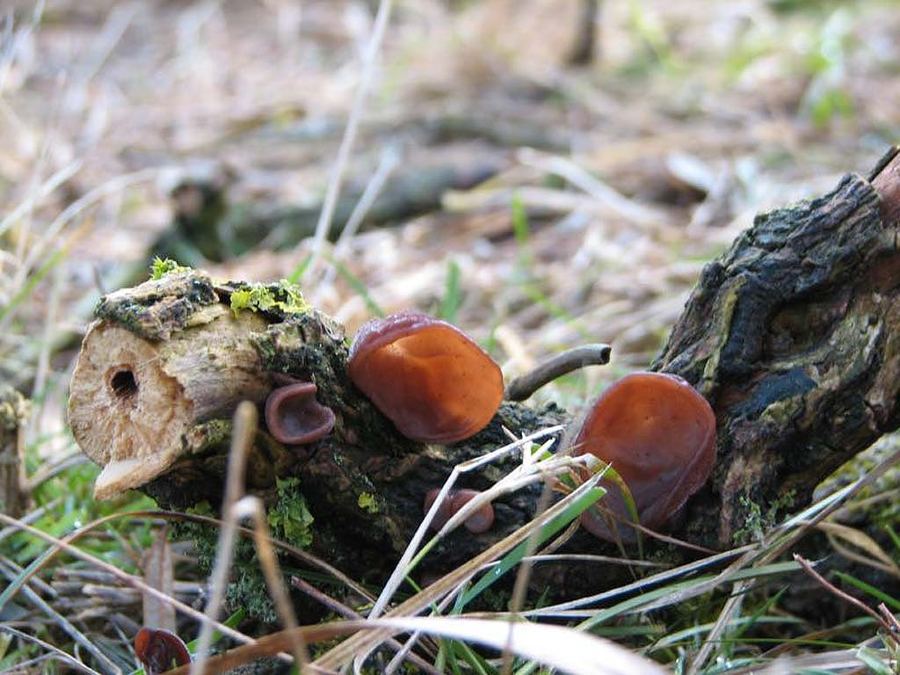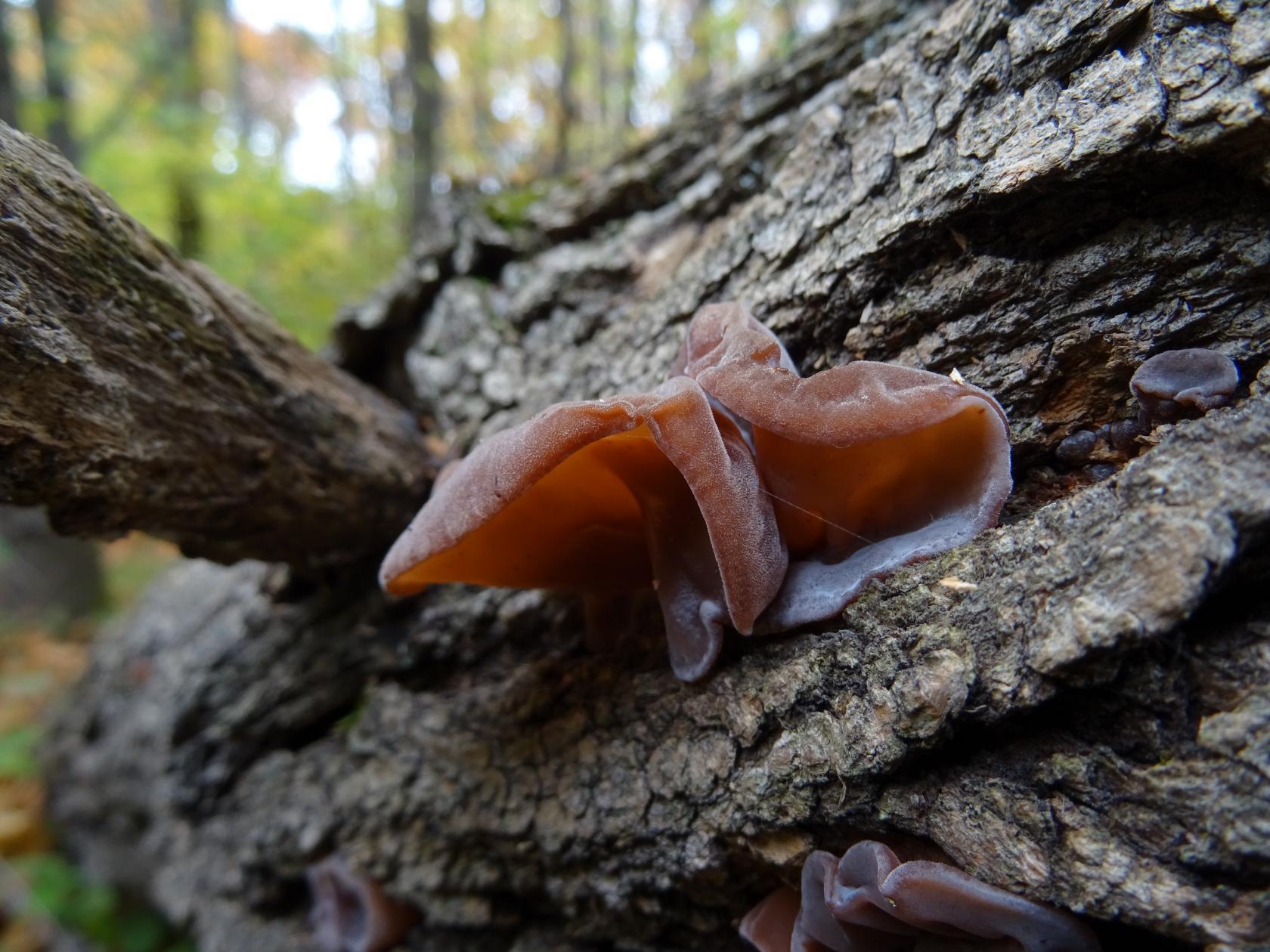Self-cultivation of auralia auricular.
These mushrooms can be grown at home. For this purpose, 2 cuts are made on the branches of maple, elderberry or linden. The mycelium of the fungus is placed in the cuts. It is recommended to use branches about a meter long and 15 centimeters in diameter.
It is advisable to land in April-May. Mushrooms are germinated at a temperature of 20 degrees in piles. The process takes 3 months, after which the logs are placed in a place protected from the sun. In warm and humid weather, fruiting bodies appear at the end of summer. With regular watering of the substrate, the fruiting bodies will grow constantly.
Although in our latitudes auricular auricularia is a rare species, this mushroom can increasingly be found on our tables.
Auricularia is a representative of cap mushrooms, which has several varieties. This woody mushroom is classified as conditionally edible because of its not too sophisticated taste. Gourmets, most likely, will not appreciate the crunchy gelatinous structure that vaguely resembles cartilage, but auricularia has gained significant popularity among medical representatives around the world. The substances and elements that this species contains have a pronounced anti-inflammatory and antitumor effect, and the first mention of the use of the mushroom for medicinal purposes dates back to the 16th century. Auricularia has several subspecies: thick-haired, ear-shaped and membranous, and the latter subspecies does not possess valuable medicinal properties. All of them are tree dwellers and have common structural features, as well as some differences.
Auricularia thick-haired
Auricularia thick-haired - Latin Auricularia polytricha
In another way, this fungus is called Exidia thick-haired.
Description
External characteristics
The height of the mushroom is no more than 100 mm, the diameter is 130-150 mm. On a barely noticeable leg rests a thin cap, no more than 2 mm thick, which has a funnel-shaped shape and is painted in brown-gray shades. The wavy edges of the hats contrast with the overall surface with a lighter coloration.
The lower part of the Exidia is densely haired, with a smooth surface, covered with plush bristles.
The mushroom is filled with brown flesh, jelly-like in young specimens and dry and dark in adult fungi. In a drought, it dries up, but when it rains, it can return to its original appearance.
The fungus reproduces by elliptical spores contained in a white spore powder.
Growing places
For good growth of dense hairy Auricularia, a humid warm climate is inherent in tropical Asian and American countries. She is also found on the Khabarovsk, Primorsky and Sakhalin lands. It grows on the bark of dead or old broadleaf trees, especially oak trees.
Fruiting lasts from early spring to late autumn.
Edibility
Rich in vitamins, proteins and amino acids, the mushroom is considered edible and deeply revered in oriental cuisine. It is served hot and added to salads, especially in Thai cuisine.
Auricularia thick-haired - Auricularia polytricha
- Auricularia is horny. Its lower part is less pubescent, and the hat is olive rather than brown.
- Auricularia is auricular. It has a very short pile and is completely colored in a brown - yellow tone, turning into a brown - red.
- Auricularia is filmy. Unlike its dense-haired analogue, this fungus has a diameter of no more than 60 mm.
Cooking use
Chinese mushrooms are both an independent product and an indispensable ingredient in a large number of oriental dishes. In addition to their medicinal properties, they have many beneficial culinary properties. Their taste is delicate, and the aroma is rich and unusual.
Judah's ear goes well with any product. Boiled or fried, it is included in salads, soups, cold appetizers, meat and fish dishes. Dried "tree ears" are used as a seasoning. Since the Chinese delicacy contains few calories, Auricularia auricularis is also used in diet meals.
How to cook
The Muer tree mushroom has an unusual feature - if you put it in water, it will begin to “grow” and increase almost 10 times, and then take on its original appearance. This property of the mushroom should be taken into account when preparing it. Before preparing the "tree ears", they must be soaked in water for at least 1 hour. The water is drained several times.
Muer does not require immediate cooking, but can be stored for a short time after soaking. Most often, it is sent to the refrigerator for a day or stored for several hours in a cool dry place.
How to brew
The Judas ear mushroom requires careful heat treatment, so it should be cooked for at least two hours. When cooked, it should be added to soups and salads. Even muer is fried only after being subjected to many hours of heat treatment. Dried muers are also cooked, it is not enough to dry the “ear” to send it to the dish in this form. But if you grind them into powder, then heat treatment is not required. In this form, "tree ears" are used only as a seasoning.
Interesting recipes
Muer tree mushroom, recipes for which are in every cookbook of oriental cuisine, is wonderful when fried. Muer is most often sold in a small black package. Before cooking, the packaging must be removed and the mushrooms must be placed in water. They will soon swell. For frying, you need only 300 g of the product.
While the "tree ears" are in the water, they cut for frying
- 4 carrots,
- 2 onions
- 2 cloves of garlic.
- Vegetable oil is poured into a preheated frying pan and vegetables are fried for 10 minutes.
- Then remove the pan from the heat a little and send the mushrooms to it.
- Fill with water, close the lid and send to stew for another 2 minutes.
- The dish is ready.
You can season it with sauce or seasoning to taste.
In Korea and China, wood-ear salad is often prepared. To do this, red pepper is fried, a little oil is added to the pan and mushrooms are added. Fry for another 2-3 minutes. Then put on a plate, add onions, coriander, aromatic herbs and various seasonings to taste. Dress the salad with soy sauce or vinegar.
Judas ear mushroom is a natural sorbent

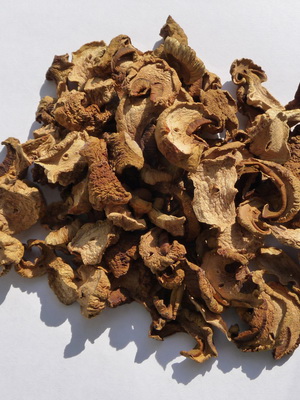
Dried mushroom is a powerful natural sorbent of natural origin, contains food cellulose and chitosan, has a high adsorption capacity, has a complex of polysaccharides - polyose, which has an immunomodulatory effect. Has a neutralizing effect that can dissolve kidney and gallstones. Poliosis and other colloidal substances contained in the mushroom interfere with the absorption of carbohydrates and fats. The mushroom also contains substances that prevent blood clots. Poliosis is particularly effective against platelet aggregation, making Judah's ear an excellent remedy for mature and elderly people, especially those with cerebral thrombosis. The pharmacological and medicinal properties of auricular auricular are widely used in traditional and folk medicine.
Poliosis also has an anti-ulcer effect, is used by pharmaceuticals to protect tissues from damage, as an anti-inflammatory agent, etc.
Experiments carried out in 1980 revealed the presence of two glucans that showed antitumor properties on sarcoma-180. Further study of auricular polysaccharides showed their hypoglycemic properties (lowering insulin levels, blood plasma glucose and urinary glucose levels).
Another complex of polysaccharides (derivatives of mannose, glucose, xylose and glucuronic acid) exhibits pronounced anticoagulant activity and is effective against thrombosis (stops platelet binding) and hypercholesterolemia. Research has also shown that A. auricula-judae can be used to lower cholesterol in general and bad cholesterol in particular.
The anti-radiation and anti-mutagenic effect of the mushroom extracts was noted.
Auricularia has long been traditionally used as a medicinal mushroom by many healers. The mushroom has been used as a poultice to treat eye inflammations and as an emollient for sore throats. Back in the 16th century, the famous English herbalist John Gerard advised the use of A. auricula-judae for specific purposes (while other mushrooms in those days were taken as general medicines). He advised preparing the extract of the fruit bodies by boiling in milk or brewing in beer, and then drinking the infusion in small sips with a sore throat. Karl Clusius in 1601 pointed out that the infusion of the mushroom should be gargled, as did John Parkinson, who wrote in 1640 that "boiling in milk or steeping in vinegar is the only known way of using it." In the 17th century, information appeared about the use of aqueous infusions to relieve eye inflammation. The mushroom has also been used as an astringent due to its high absorption capacity. The medicinal use of aulicularia is known in the 18th century in Ireland and Scotland (sore throat and jaundice). The medical use of auricularia was noted in the 1930s in Indonesia. Currently, the mushroom is used as a medicinal in Ghana (as a tonic for the circulatory system).
The main indications for prescribing the drug in traditional medicine:
1. Acute poisoning (as a substitute for activated carbon) and chronic intoxication of various origins, including after chemotherapy and radiation therapy, to improve the quality of blood, prevent intestinal dysbiosis.
2. Normalization of digestion in persons with chronic diseases of the gastrointestinal tract against the background of enzymatic insufficiency (pain syndrome, diarrhea, flatulence).
3. Complex treatment of allergic diseases.
4. Weight loss and normalization of metabolic processes (with gallstone and urolithiasis), as well as in the treatment of diabetes mellitus.
5. Prevention and treatment of cardiovascular diseases - arterial hypertension, coronary heart disease, lipid metabolism disorders. An improvement in blood microcirculation was noted.
6. Comprehensive treatment and prevention of benign and malignant tumors.
7. As a gerontological agent against aging.
8. Hemostatic and anesthetic.
Collection and procurement rules for medicinal purposes. Fresh fruiting bodies are harvested for drying. Use dry whole, in the form of powder or infusions.
Food use, culinary advice. The mushroom is prized in the Far East, especially in Chinese cuisine. It is a must-have ingredient in many Chinese soups and nutritional dishes. Can be eaten raw in salads.
Contraindications and possible harm from the use of auricularia
The best materials of the month
- Why you can't go on a diet on your own
- How to keep vegetables and fruits fresh: simple tricks
- How to beat your sugar cravings: 7 unexpected foods
- Scientists say youth can be prolonged
Nutritionists do not recommend using the product for pregnant women and nursing mothers. It can be introduced into the children's diet from 5-6 years old.
There are also known cases of individual intolerance to the fungus, therefore, the use of exotic auricularia should be started gradually - from 1-2 pieces in everyday dishes.
People with diseases of the pancreas and gallbladder should be careful about fungi in general, and auricularia in particular - they can provoke an exacerbation of painful conditions. Judas ear, “wood jellyfish” or auricularia mushroom is a product unique in its value for human health.
Its two subspecies contain a significant amount of nutrients, vitamins, mineral elements that help fight cancer, inflammatory processes, and the effects of radiation exposure. In Asian countries, this tree dweller has long been appreciated, and even a specific, initially not very pleasant taste, is beaten with the help of original recipes
Judas ear, “woody jellyfish” or auricularia mushroom is a product that is unique in its value for human health. Its two subspecies contain a significant amount of nutrients, vitamins, mineral elements that help fight cancer, inflammatory processes, and the effects of radiation exposure. In Asian countries, this tree dweller has been appreciated for a long time, and even a specific, initially not very pleasant taste, is beaten with the help of original recipes.
Considering how much benefit this exotic and rare mushroom can bring, it deserves a separate place in the home medicine cabinet and in stocks of preparations for the winter. It is not very suitable for salting, but it can be dried - in this form it can be stored for a long time, practically without losing its healing properties.
More fresh and relevant health information on our Telegram channel.
We will be grateful if you use the buttons:
Useful properties and possible harm
The calorie content of muer per 100 g is 30 kcal. In its chemical composition:
- 4.8 proteins;
- 2.4 carbohydrates;
- 6 g of ash;
- 13 g of water;
- no fat.
Dishes made from these mushrooms are said to be healthy and have medicinal properties.
The increased proportion of protein and calcium makes it a full-fledged meat substitute in terms of nutritional value, and in terms of the amount of phosphorus it contains, it is not inferior to fish. Vitamins from group B, ascorbic acid, D, calcium, iodine, iron, potassium, enzymes and amino acids are also present in large doses.
In chemical composition, it has common characteristics with the porcini mushroom: fiber and chitin are included in a large volume, acting as neutralizers of toxins and participating in digestive processes.
Irina Selyutina (Biologist):
During the research, the ability of the fungus to anticoagulation was revealed, comparable to the action of heparin.
- Anticoagulation - reducing blood clotting with certain medications.
- Heparin is an anticoagulant that prevents blood clotting, discovered in 1916.
The fungus is not toxic. In nature, it does not have poisonous twins, it cannot be confused with other inedible woody representatives. The use of muer should be limited to people with diseases of the liver, digestive organs, increased secretion of the thyroid gland, as well as those who are prone to allergic reactions in the form of eczema and dermatitis. Contraindicated for children under 14 years of age.
Use of auricular auricular in medicine.
These mushrooms are widely used in folk and traditional medicine. Auricularia auricular acts like activated charcoal in case of poisoning. Judah's ear is recommended after radiation and chemotherapy, as it improves blood composition. In addition, auricularia improves the digestive processes in diseases of the intestines and stomach. These mushrooms show good results in case of allergic reactions. They are also used as additives to improve metabolism and reduce body weight.
In addition, auricular auricular has a therapeutic effect in case of heart diseases and problems with the vascular system. It has a beneficial effect on blood clotting, therefore, reduces the risk of blood clots.Also, auricular auricular helps in the presence of various tumors, not only benign, but also malignant. It has a hemostatic, anti-inflammatory and analgesic effect.
Contraindications for the use of auricular auricular.
Like any drugs, auricular auricular, has certain contraindications for use. It is not recommended to start treatment during pregnancy and lactation. Also, you should not give these mushrooms to children under 10 years old. In certain cases, individual intolerance may be observed.
The composition of the auricular auricular.
Auricularia auricular has a high nutritional value. Its pulp is rich in protein, carbohydrates, vitamins, macronutrients and trace elements. They are especially rich in vitamins B. Also, the composition includes magnesium, calcium, silicon, potassium and other elements.
Cooking applications
This mushroom has great nutritional value. It is rich in carbohydrates and protein, vitamins, especially group B, micro and macro elements. This plant contains a lot of potassium, calcium, magnesium, silicon and other minerals. It is massively used in oriental cuisine. Allowed to use fresh and dried. Most often it is eaten boiled, but sometimes young mushrooms are eaten raw. The "black ear" is usually sold in dried form. Before using it, you need to soak it and then it will take its original form. There are many recipes in Chinese cuisine using this mushroom.
Soup with Auricularia mushrooms and seafood.
The amount of ingredients is calculated for 2.5 liters of broth. Soak a handful of dry mushrooms in warm water. At this time, we are preparing other products. Cut the onion head into thin half rings, one bell pepper and 5-6 champignons into strips, 150 grams of fresh salmon or salmon - cubes. Lightly sauté the onion in vegetable oil, add pepper and mushrooms to it. Cut "Auricularia" into small pieces. Add fried vegetables and mushrooms to the boiling broth, after five minutes you can put rice noodles (100 grams). Before turning off, add salmon and 15 shrimps, bring to readiness for a minute.
Soup "Great Wall of China".
Pre-soak a handful of dry mushrooms in room temperature water, cut into thin strips and fry in olive oil, adding a tablespoon of soy sauce. Bring 1.5 liters of water to a boil, add half a teaspoon of salt, a little grated ginger, a slice of lemon, a whole peeled onion and mushrooms. Reduce heat to low and cook soup for 20 minutes. After that, remove the onion and lemon, add half a packet of rice noodles, a tablespoon of apple cider vinegar, a teaspoon of sugar, salt, pepper. Cook for about 10 minutes. Serve this soup to taste with sour cream, soy sauce and herbs.
Of the second courses, the following options are of interest:
Meat strips.
Soak a box of mushrooms for 30 minutes. Cut 200 grams of lean pork into thin strips, add salt, 25 grams of rice starch, mix. Cut 2 carrots and 2 sweet peppers into strips. For the sauce, mix 13 gr. soy sauce, 10 g of rice vinegar, salt, sugar to taste and 15 g of rice starch diluted with water. Fry the meat, chopped onion, garlic and ginger over high heat in vegetable oil, add hot red pepper, mushrooms, carrots, bell peppers and simmer until tender. Serve with sauce and herbs.
Chinese Tsai salad.
For him you will need boiled or smoked chicken, cucumber, carrots, onions, mushrooms, funchose, eggs, starch and spices. Cut the chicken into strips, three cucumbers and carrots on a grater, fry the mushrooms with onions, boil the funchose. We bake pancakes from eggs and starch, which we also cut into strips. We put all the ingredients in a deep salad bowl, add soy sauce, spices, mix thoroughly.
Growing auricular auricular at home
You can grow auricularia at home.To do this, two cuts are made on the branches and trunks of deciduous trees (elderberry, maple, linden), into which the mycelium is placed. The optimal size of pieces of wood: 15 cm in diameter and about a meter in length. It is best to land in April or May. The grafted substrates are piled up. Germination is carried out at a temperature of +20 degrees for 3 months. Then the logs must be installed in a place protected from the sun. If the weather is humid and warm, then fruiting bodies appear by the end of summer. If the logs are watered, new plants will appear regularly. Auricularia are collected when white spores appear on the underside of the cap. The mushrooms continue to grow for about six years.
Despite the fact that Auricularia auricular is a rather rare plant in our area, it appears more and more often on our table, adding sophistication and originality to dishes. And next time picking mushrooms, try looking for this unusual plant on tree trunks.
Use of auricular auricular in medicine.
These mushrooms are widely used in folk and traditional medicine. Auricularia auricular acts like activated charcoal in case of poisoning. Judah's ear is recommended after radiation and chemotherapy, as it improves blood composition. In addition, auricularia improves the digestive processes in diseases of the intestines and stomach. These mushrooms show good results in case of allergic reactions. They are also used as additives to improve metabolism and reduce body weight.
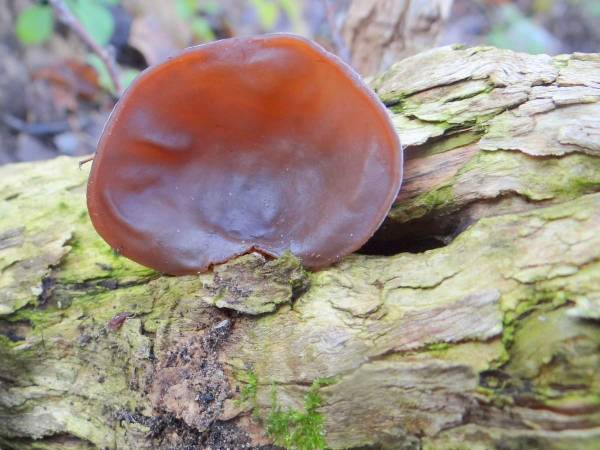
In addition, auricular auricular has a therapeutic effect in case of heart diseases and problems with the vascular system. It has a beneficial effect on blood clotting, therefore, reduces the risk of blood clots. Also, auricular auricular helps in the presence of various tumors, not only benign, but also malignant. It has a hemostatic, anti-inflammatory and analgesic effect.
Contraindications for the use of auricular auricular.
Like any drugs, auricular auricular, has certain contraindications for use. It is not recommended to start treatment during pregnancy and lactation. Also, you should not give these mushrooms to children under 10 years old. In certain cases, individual intolerance may be observed.
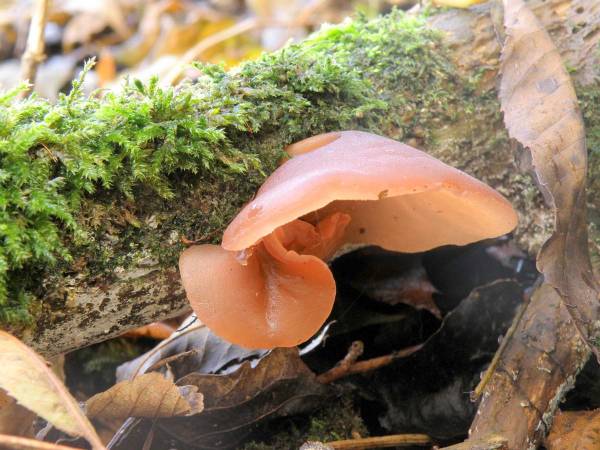
The composition of the auricular auricular.
Auricularia auricular has a high nutritional value. Its pulp is rich in protein, carbohydrates, vitamins, macronutrients and trace elements. They are especially rich in vitamins B. Also, the composition includes magnesium, calcium, silicon, potassium and other elements.
Auricularia auricular
The Latin specific epithet and popular names in many European languages come from the biblical legend of Judas Iscariot, who hanged himself on an elder.
The Chinese name for the mushroom mu er (木耳, pinyin: mù ěr) translates as "tree ear".
The Japanese name kikurage (キ ク ラ ゲ) literally means tree jellyfish.
The fruiting body is sessile, ear-shaped, 4-10 cm in size. The outer surface is reddish-brown, covered with soft hairs, the inner surface (hymenophore) is smooth, darker, with a grayish tint, covered with veins and wrinkles.
The pulp is thin, gelatinous, transparent, hardens and shrinks when dry. White spore powder, spores 14 × 5.5 μm, elongated-ellipsoidal.
Ecology and distribution
It grows on weakened and dead deciduous trees (parasite or saprotroph), most often on elder, alder. Found in humid places in deciduous forests, widespread in the warmer part of the northern temperate zone.
Similar Species: Auricularia polytricha
The mushroom is prized in the Far East, especially in Chinese cuisine. An obligatory ingredient in the Chinese Black Mushroom soup. Dishes made from this mushroom are considered medicinal in China. It can also be used in salads.
Already in the 3rd century AD, this mushroom was appreciated in China and used in food. There he was called mu-err, which can be translated as "ear of a tree."In ancient China, 5 different species were known. They were collected during rainy periods and dried.
In Japan, China and Taiwan, Judah's ear and other related species, for example, are now grown. Auricularia polytricha on thin trunks of various deciduous trees.
In Germany, the "elderberry mushroom" has been used for centuries as a medicine. It was applied to sore eyes or an infusion was made from it for rinsing, which helps with diseases of the nasopharynx. Now these treatments are forgotten.
But, perhaps, the extract of auricularia will soon regain some importance as a medicine: the most recent studies have revealed that this mushroom contains substances that prevent thrombus formation.
In Japan and Taiwan, there is also a white gelatinous mushroom (Tremella fuciformis), also called "silver ear". He is also credited with medicinal properties. It grows on the thin trunks and branches of many deciduous trees.
In Taiwan, a drink is prepared from its crushed fruit bodies: mushrooms are washed down with hot syrup, adding pieces of cherry or pineapple to it. Unlike auricularia, the cultivation of white gelatinous fungus in Germany is not yet engaged.
Growing in the garden
Judas ear takes root better on branches and trunks about 15 cm in diameter and 1 m long. Black elderberry, maple, elm and other deciduous trees are suitable. The best times for inoculation are April and May. Auricularia mycelium is difficult to acquire. It is recommended to use the cuts inoculation method, with 2 cuts made on each piece of wood.
The grafted branches or logs are folded into piles in a known manner. The mycelium is germinated at a temperature of about 20 ° C for 2-3 months.
Then the collars are disassembled and the logs are placed in a shaded place crosswise (see shii-take) or the logs are leaned against the trees. In humid and mild weather, the first fruiting bodies may appear already at the end of summer. The optimum temperature is from 18 to 23 ° C, the optimum humidity is above 90%.
If the logs are watered regularly, mushrooms will reappear after a short period of rest. Later, when white spores appear on the underside of the mushrooms, the auricularia are cut close to the tree trunk. The growth of fungi lasts from 3 to 5 years and yields from 12 to 14% of the wood mass. In China and Japan, Judah's ear is cultured on a sterilized mixture of sawdust and rice bran in plastic bags.
A similar method, which could be used by amateurs, has not yet been developed. There is also almost no information about the reasons for the failures.
Judas ear (Auricularia auricula-judae) in the tree garden
Use, storage, canning
In Chinese cuisine, auricularia is fried, stewed, but mostly steamed with meat, fish or vegetables. For storage, the mushrooms are dried whole. At the same time, they become almost black, only the underside of the cap remains light.
If you put them in warm water, they will swell and after about an hour they will return to their previous shape, color and consistency.

